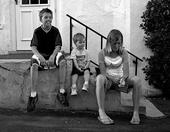I always have said that Films speak to me right away, The atmosphere, the overall mood dictates the kind of orchestra I will use. Watching a film the first few times, I make a charcoal sketch; later I put the colors in. In recording my film scores, I often create My own orchestrations and prefer to conduct the orchestra directly to picture, instead of using click tracks or other mechanical timing devices.My early interest in avant-garde musical techniques helped define My personal style, which often blends traditional harmonies and a conventional orchestral palette with the texture of ethnic instruments and even electronic sounds. Film scoring became an obvious choice for Me, though I bring to it the perspective of the classical composer and conductor.
How I started I began writing for films in 1980, shortly after completing Doctorate in composition at UCLA, following earlier study at London's Royal Academy of Music and University of Southern California. Myirst assignment was the scoring of a short film entitled The Drought for the American Film Institute, and it led to more work with AFI. Ifurther developed acraft in the commercial arena at New World Pictures, under the aegis of low-budget producer Roger Corman. At New World Pictures Ialso forged important long-term relationships with two emerging young directors, Ron Howard and James Cameron. Myontrasting scores for Brainstorm and 48 HRS. (which Ion a Los Angeles Film Critics Association award) helped establish meas an important and versatile new film composer, just as the symphonic film score became popular in the wake of John Williams's music for the Star Wars films. Iwent on to write scores for such films as Casper, Clear and Present Danger, The Man Without a Face, Patriot Games, Sneakers, The Rocketeer, In Country, Honey I Shrunk the Kids, The Land Before Time, Willow, An American Tail, The Name of the Rose, Cocoon and Star Trek II: The Wrath of Khan.
